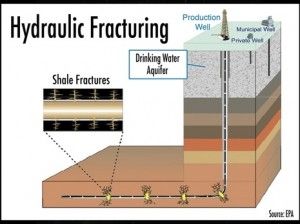Why Has Oil and Gas Boom Skipped CA?
By WAYNE LUSVARDI
New extraction technologies are creating an oil and gas boom that is lifting the economics of several states, as reported by the Wall Street Journal’s recent article “Oil and Gas Boom Lifts U.S. Economy.”
Median incomes are growing since 2007 in such states as Wyoming, Alaska, North Dakota, Oklahoma and Texas. Conspicuously absent is the State of California, which ironically has the third largest oil reserves in the United States and two-thirds of all the shale oil reserves, according to the U.S. Energy Information Service.
About 158,500 new oil and gas jobs have been created over the last five years across America. But it is the economic multiplier effect that this boom is creating in the wider economy that is spreading the boom beyond the oil patch. Jobs and incomes are growing for truck drivers, manufactured home builders, energy traders and landowners with oil and gas leases. According to independent economist Tim Considine, every oil and gas sector job supports four additional jobs.
But perhaps more importantly, natural gas is providing such cheap energy that manufacturing plants are reportedly returning to the America, or considering a return. Reportedly, Asian-based industries have to pay up to six times as much for natural gas as industries in Texas or Louisiana. To lay the base for reindustrialization, cheap energy may be the key.
The question remains: Why is California suffering from economic lag when other states are lifting their economies out of the recession through oil and gas drilling?
Red States Booming — Blue States Lagging
Perhaps California’s turn to expensive green power is one reason why, thus far, it has not been a part of this new oil and gas boom, or the reindustrialization. But Texas has been as expansive with green power as California.
Perhaps the table below is indicative of why California has not shown a recovery in median incomes since 2007. The table shows the shale oil reserves in several oil and gas producing Western states compared with the change in median incomes since 2007. Also shown is the political majority of the legislature of each state. Red states are booming and Blue states are showing no recovery.
Since 2007, several western states have shown growth in median incomes. Most notable are those states with active oil and gas drilling. Median income have grown since 2007 in Wyoming by 3.68 percent, in North Dakota by 2.9 percent, in Oklahoma by 1 percent and in Texas by 0.8 percent. But the median income in California has dropped by -3.4 percent and in New Mexico by -0.2 percent.
Median Income Change in Oil & Gas Producing States in Western U.S.
| States | Shale Formation/ Percent Total |
Median Income 2007 | Median Income 2010 | Percent Change | Red/Blue State Legislature Majority |
| California | Monterey Formation64.4 Pct. | $62,114 | $60,000 | -3.4 Pct. | Blue Democratic |
| North Dakota | Bakken Formation15 Pct. | $46,905 | $48,245 | +2.9 Pct. | RedRepublican |
| Texas | Eagle FordFormation
13.9 Pct. |
$48,218 | $49,600 | +0.8 Pct. | Red Republican |
| Wyoming | Green River FormationUnk. Pct. | $52,794 | $54,700 | +3.68 Pct. | Red Republican |
| Oklahoma | Barnett and Woodford FormatioUnk. Pct. |
$42,468 | $42,900 | +1.0 Pct. | Red Republican |
| New Mexico(W. Texas) | Avalon & Bone SpringsFormation
6.5 Pct. |
$43,603 | $43,500 | -0.2 Pct. | BlueDemocratic |
As reported in the Wall Street Journal, communities that are benefitting from oil and gas drilling are seeing it as an economic “game changer.”
However, communities in California are faced with:
* The only active Cap and Trade tax on large industries in the United States.
* The only Green Chemistry Law that requires industries to prove at great cost that there chemical products do not have a safer alternative.
* A proposed near-zero standard for perchlorate in drinking water with no discernible health benefits, but huge cleanup costs on industries and water and electric utilities.
* The highest combined tax rates in the United States.
* An environmental impact law that can be gamed worse than Enron ever did to protect monopolies and erect trade barriers.
While California currently seems engrossed with High-Speed Rail projects, renewal of public funding for redundant stem cell research and putting more pro-tax initiatives on the upcoming November ballot, other states are proceeding with a renaissance of the oil and gas industries. This has serious implications for the upcoming presidential and congressional elections outside California in November.
CA’s De-Modernization Model
Going all the way back to when the state limited the influence of the monopoly Southern Pacific Railroad, California has embraced counter-modernization and de-industrialization as its economic and political model. This has provided an alternative to the harshness and alienation of the modern world. But the United States is on the verge of near energy self-sufficiency and re-industrialization that may leave California behind.
Conversely, California remains an over-regulated state whose only way to compete is to erect trade barriers and impose taxes wherever possible. This will continue to wreak serious consequences on its state budget and the unsustainability of its government pension funds.
It is unlikely that California will change from de-modernization back to reindustrialization in the near future. As such, California is likely to continue to lag behind other states that are benefitting from the oil and gas boom and the re-industrialization that comes with it.
Related Articles
Budget ‘transparency’ murky in Senate
June 14, 2013 By Katy Grimes SACRAMENTO — I watched in dismay as Senate Democrats voted yesterday to bypass proper
Think tank explained CA’s affordable housing debacles long ago
A weekend story about the gross failure of affordable housing policies in San Francisco contained plenty of public frustration and
Wired is "tired"on Cali mass transit
Wired magazine runs a “wired/tired” feature, in which they judge new technologies as being “wired” — up-to-date, hip, cool, etc.




